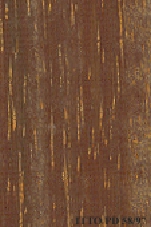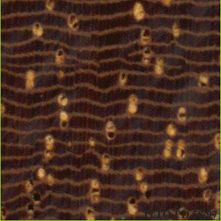
AZOBé (Lophira alata)
Trade Name
Azobé
Scientific Name
Lophira alata Banks
Family
OCHNACEAE
Common Names
Azobe (Côte d`Ivoire); Yasua; Umpenek; Umawerek; Red oak; Red ironwood; Prenkebi; Pone; Plu; Parapara; Ozobe; Otugba; Oteng; Okut; Okoka; Okoga; Okoa; Okikopom; Nokue; Ngohou ibenga; Namijin-kadai; N`goule; Meni oil tree; Malah; Liku; Lihos; Kyirebente; Kyirafunti; Kyere; Kunu; Kotublassu; Kokank; Kekrefunde; K`deng; Ironpost; Ipawhaw; Gue; Faboy; Esire; Enwan; Endui; Eleba; Ebba; Bokoka; Belengbe; Bankile; Asore; Akpakpla; Akogo; Akogka; African oak; A koura; Bongossi (Germany); Endwi (Sierra Leone); Aba (Nigeria); Eba (Nigeria); Esore (Côte d`Ivoire); Bakundu (Cameroon); Ekki (United Kingdom); Bonkole (Germany); Akoga (Equatorial Guinea); Bonkole (Congo); Akoga (Gabon); Bongossi (Cameroon); Ekki (Nigeria); Kaku (Ghana); Hendui (Sierra Leone); Azobe
Scientific Name Synonyms
Lophira tholloni Tiegh.; Lophira spatulata Tiegh.; Lophira simplex G. Don; Lophira procera A. Chev.; Lophira macrophylla Tiegh.; Lophira barteri Tiegh.; Lophira africana Banks ex G. Don
Description Of The Tree
Botanical Description
The tree reaches a height of 50 m, with trunk diameters up to 150 cm. The bole is usually straight, clear and cylindrical up to 30 m long. Not buttressed, but sometimes it is swollen at the base.
Natural Habitat
Lophira alata is a pioneer species and occurs abundantly in wet evergreen forest. It is reported to grow in evergreen and moist deciduous forests, freshwater swamp forests, and close to riverbanks. It is known or inferred that the harvesting of specimens
Natural Distribution
West Africa.
Plantations Available?
It has been planted in Cote d`Ivoire since 1926; it is a long rotation species for plantation. The duration of the rotation is 50 years, to reach 60 cm in diameter.
Wood Identification
Anatomic Description Of Wood
Wood diffuse porous. Occasionally vessels exclusively solitary (over 90%). Tangential diameter of vessel lumina 200 micras or more (large). White deposits in heartwood vessels. Vestured pits. Vessels per mm2 less than 6 (rare). Simple perforation plates. Vessel- Axial parenchyma in continuous tangential lines or fine bands. Prismatic crystals in non-chambered axial parenchyma cells. Prismatic crystals in short chains in chambered axial parenchyma cells. Over 9 cells per parenchyma strand. Axial parenchyma bands more Rays more than 10 per mm (abundant). Rays non-storied. Rays commonly 2 seriate. Homogeneous rays and/or sub-homogeneous rays (all ray cells procumbent). Non-septate fibers. Fibers with simple to minutely bordered pits.
-
 Wood Macro Photo Tangential Plane
Wood Macro Photo Tangential Plane
-
 Wood Micro Photo Of Transversal Section
Wood Micro Photo Of Transversal Section
Availability
Cites Status
Unrestricted
General Wood Description
Color
The sapwood is pale pink, it has a thickness of 5 cm. The heartwood is dark red to purple-brown, white deposits in the pores, it is clearly demarcated.
COLOR INDEX (1=Black, 7=Light yellow,white)
2
Grain
The grain is slightly but systematically interlocked; special care is needed when drying because of frequent risks of distortion.
Texture
The wood is mostly coarse in texture.
Natural Durability
Durable to decay; this species can be utilized without preservative treatment for exterior joinery or similar uses. Resistant to termites attack. Heartwood is resistant to Lyctus attacks.
Natural durability index (1= Very high durability, 7=Vey low durability)
1
Internal Growth Stresses
No growth stresses are reported in this species.
Silica Content
Silica Content: Negligible content of silica is reported. Amounts over 0.05% may affect wood processing. Silica Value: 0.03
Resistance To Impregnation
Nearly impossible to treat with a too much low penetration of the preservative substances.
Wood Physical Properties
Basic Density or Specific Gravity (O.D. weight/vol. green) (g/cm³)
0.91
Air-dry Density (Weight and volume at 12%MC) (g/cm³)
1.06
Total shrinkage Tangential (Saturated to 0%MC) (%)
10.3
Total shrinkage Radial (Saturated to 0%MC) (%)
7.3
Drying Defects
Ease of Drying: Drying is moderately easy; some particular care is needed. Drying Defects: Risks of distortions when interlocked grain is present. Kiln Schedules: The kiln schedule has been tested.
Recommended Dry Kiln Schedule
FR-13
Dimensional stability ratio (Total Tangential Shrinkage %/Total Radial Shrinkage %)
1.4
Wood Chemical Properties
Wood Mechanical Properties
Bending Strength (MOR),12%MC (kgf/cm²)
1654
Stiffness (MOE) 12%MC (kgf/cm²)
218336
Compression parallel to fiber 12%MC (kgf/cm²)
975
Compression perpendicular to fiber 12%MC (kgf/cm²)
151
Shear strength radial 12%MC (kgf/cm²)
148
Janka hardness (side) 12%MC (kgf)
1429
Janka hardness (end grain) 12%MC (kgf)
1389
Workability
Sawing
Sawing of this species requires powerful equipment.
Rotary Veneer Cutting
Not suitable for veneering.
Sliced Veneer
Not suitable for veneering.
Blunting Effect
Moderate blunting effect; stellited blades for sawing and carbide tools for machining are advised.
Machining
It needs powerful tools for processing. Possible difficulties caused by interlocked grain are reported.
Planing
Rather difficult; special tools are needed.
Moulding
Moderately easy; tools must be cautiously sharpened.
Boring
Moderately easy; tools must be cautiously sharpened.
Mortising
Moderately easy; tools must be cautiously sharpened.
Nailing
Pre-boring is necessary.
Gluing
Difficult to glue because of high density.
Sanding
Easy to perform; it gives good results.
Polishing
Needs pre-coating.
Steam Bending
Steam bending is difficult.
Response To Hand Tools
Working with hand tools is difficult.
REFERENCED USES
End Uses Summary
EXTERIOR GENERAL, bridges, poles, paling, stakes posts, rails, crossarms, crossties, piers, HOUSING GENERAL, beams, flooring, parquet, CONTAINERS, cooperage, truck bodies, truck flooring
Exterior General
- 1 - Tabela de resultados de ensaios fisicos e mecanicos
Bridges
- 2 - 25 madeiras da amazonia de valor comercial, caracterizacao, macroscopica, usos comuns e indices qualificativos
Poles
- 3 - Estudo dendrologico e determinacao das caracteristicas fisicas e mecanicas do genipapo (Genipa americana)
Paling Fence Pickets
- 4 - Estudo dendrologico e determinacao das caracteristicas fisicas e mecanicas da bicuiba
Stake Posts
- 5 - Propriedades fisicas e mecanicas da madeira e do contraplacado de Pinus elliottii
Rails
- 6 - Physical and mechanical properties of Eucalyptus deglupta Blume grown in Costa Rica
Crossheads Crossarms
- 7 - Maderas latinoamericanas. II, Quercus alata Q. costaricensis y Q. eugeniaefolia
Crossties
- 8 - Maderas latinoamericas. III, Podocarpus standleyi ,Podocarpus oleifolius, Drims granadensis, Magnolia poasana y Didymopanax pittieri
Piers
- 9 - Maderas latinoamericanas. IV, Nectandra sp. Ocotea austinii, Persea sp. aff. vesticula, Persea schiedeana
General Housing
- 10 - Silica in Timbers
Beams
- 11 - Prospect: The wood database
Flooring
- 14 - Handbook of Hardwoods
Parquet
- 15 - Empire Timbers
Cooperage
- 51 - Recopilacion de propiedades mecanicas de maderas creciendo en Chile
Truck Body
- 53 - Timbers of the New World
Truck Flooring
- 54 - Bulletin of the Government Forest Experiment Station N.157: Identification of Tropical Woods
Please Provide Information To View Producer Information